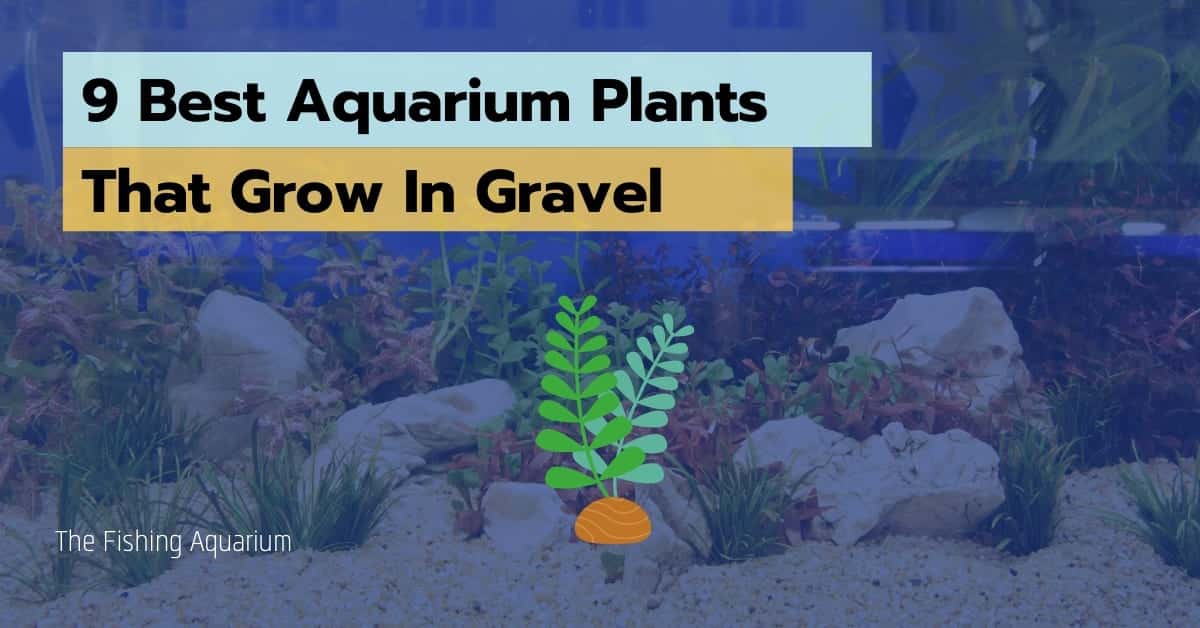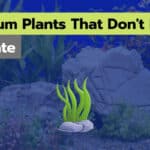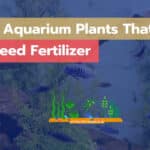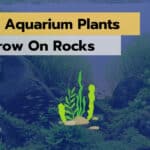With aquariums becoming more and more popular, aquarium plants have become a staple in aquarium keeping.
There are many aquarium plant species out there that grow well in gravel.
In this article, we will discuss 9 of the best aquarium plants that grow in gravel that thrive well when planted in gravel substrate.
We will also go over the benefits and drawbacks to each one so you can make an informed decision on which ones to include in your setup!
Contents
- 9 Best Aquarium Plants That Grow In Gravel
- Benefits Of Growing Aquarium Plants In Gravel
- Drawbacks Of Growing Aquarium Plants In Gravel
- Is Gravel a Good Substrate For Aquarium Plants?
- Do Aquarium Plants Grow Better in Sand or Gravel?
- How To Plant In a Gravel Aquarium?
- What Is Considered as Best Gravel For Aquarium Plants?
- Conclusion
9 Best Aquarium Plants That Grow In Gravel
With aquarium plants being so popular, many people are choosing to include them in their aquarium setups. However, there are some key things you need to make sure of before adding them!
The key things are: Aquarium plants need substrate, fertilizer, and lighting.
By ensuring these three things are at the ready you will have great success with your aquarium plants!
So here is the list of 9 best aquarium plants that grow in gravel:
- Anubias Nana
- Java Fern
- Staurogyne Repens
- Amazon Sword Plant
- Echinodorus Horemanii
- Echinodorus Bleheri
- Aponogeton Crispus
- Rotala Rotundifolia Red
- Dwarf Sagittaria Subulata (Dwarf Hair Grass)
Anubias Nana
Anubias nana is a very easy aquarium plant to care for in an aquarium. Even if they are not getting enough light, they will still grow slowly and stay green.
They do well when planted into gravel substrate because their rhizomes actually hang over the side of your aquarium!
This means you don’t have to worry about planting them, and you can still view their pretty round leaves.
Every three weeks or so, you should pull the plants out of the aquarium and check for algae on the leaves, and debris caught in their roots.
When you see dirt trapped in the rhizome it’s time for a good cleaning!
As far as aquarium plants that grow in gravel go, it doesn’t get much better than Anubias Nana! This aquarium plant does well in most aquarium conditions but prefers a lower light.
Java Fern
Java fern is another very easy aquarium plant to care for in an aquarium.
It forms thick green leaves with red veins on long stalks which can attach to aquarium gravel.
It is also very easy to attach the Java fern aquarium plant to driftwood, aquarium décor, or even the aquarium glass with aquarium silicone glue!
Java Fern does well when planted into aquarium gravel because they form roots very easily.
You may need to trim the leaves on your aquarium plants every few weeks because they grow so quickly, but that’s about the only aquarium plant care you need to worry about!
Staurogyne Repens
Staurogyne Repens is a very easy aquarium plant to care for in an aquarium. It doesn’t require much light and will grow slowly even if they don’t get enough light.
When planting aquarium plants into aquarium gravel it’s especially important that you keep an eye on the aquarium water flow.
Because this aquarium plant has such fine leaves, the aquarium water flow must be gentle!
If the aquarium gravel is trapped inside of aquarium plant pots, you should use aquarium mesh or aquarium fish tank bubbler to create a low current for this aquarium plant.
Staurogyne Repens does well when planted into aquarium gravel because they have small roots which are easily trapped in the gravel.
It’s important to keep aquarium gravel clean because aquarium sludge can build up quickly in the aquarium gravel and harm this aquarium plant.
Amazon Sword Plant
The Amazon Sword Plant is an aquarium plant that does well when planted into aquarium gravel. It has large, broad leaves which are perfect for aquarium gravel!
As long as you keep the aquarium water flow low, aquarium gravel provides a great place to anchor this aquarium plant.
You should not bury the roots of your aquarium plants too much or it may drown them!
If you plant Amazon Sword aquarium plants into aquarium gravel, they do require a certain amount of aquarium gravel in your aquarium!
Amazon Sword aquarium plants need a lot of minerals and nutrients to stay healthy.
If you’re going with aquarium gravel as a substrate for aquarium plants, make sure to add some fertilizer when planting Amazon Sword aquarium plants.
Echinodorus Horemanii
Echinodorus Horemanii is an aquarium plant that does well when planted into aquarium gravel.
Echinodorus Horemanii aquarium plants are very beautiful with their long green leaves and red veins! They do well in aquariums with higher light, but will still thrive in aquariums with lower light.
When planting aquarium plants into aquarium gravel it’s especially important that you keep an eye on the aquarium water flow.
Echinodorus Horemanii aquarium plants grow quickly and their aquarium leaves get big, so you need to make sure they don’t get torn up in your aquarium filter intake!
Echinodorus Horemanii does well when planted into aquarium gravel because they form roots easily.
Because aquarium gravel provides a place for aquarium plant roots to anchor, this aquarium plant is easy to care for!
Echinodorus Bleheri
The Echinodorus bleheri aquarium plant is one of the most popular aquarium plants.
They are sold by nearly every aquarium plant retailer.
This aquarium plant has long lanceolate-shaped leaves that grow up to 6 inches long but may reach 8 or 9 inches in length under high light conditions.
Echinodorus Bleheri aquarium plants have a moderate growth rate.
Although it has a high light requirement, Echinodorus Bleheri aquarium plants grow well in lower-light aquarium tanks.
It is an aquarium plant that grows equally well in aquarium gravel and aquarium sand.
Aponogeton Crispus
A very rare aquarium plant, this is one of the most beautiful aquarium plants.
The leaves are grooved and green with white margins.
This makes it an attractive aquarium plant to have, especially if you have another hardscape in your aquarium as well so that your aquarium looks vibrant.
Please take note that this specific species of Aponogeton aquarium plant has very specific aquarium care requirements.
It loves to be planted in aquarium substrate which is 6 inches deep, with no CO2 injection and high aquarium lighting conditions.
Rotala Rotundifolia Red
This aquarium plant has a beautiful reddish color, with very delicate round leaves which make it look like a small bush.
It is best planted in aquarium substrate at around 2-3 inches deep for the aquarium plant to grow optimally.
The Rotala Rotundifolia Red aquarium plant requires low lighting conditions and nutrient-rich water.
The aquarium plant also needs good aquarium lighting to grow well.
The aquarium plant is best planted at the back of the aquarium as it can reach up to 15 inches tall in suitable conditions.
A light substrate for this aquarium plant is aquarium gravel or aquarium sand.
This aquarium plant will do better with regular water changes to ensure that nutrients are maintained, however, its nutrient requirements are low.
The aquarium plant can also grow in hard water, but will not be as healthy and may develop brown edges on its leaves if the aquarium water is too hard.
To achieve a healthy aquarium plant, regular partial water changes should be performed to ensure that the aquarium substrate does not become soft or acidic.
Dwarf Sagittaria Subulata
Dwarf Sagittaria is suitable for aquariums, ponds, and water gardens.
This aquarium plant comes from South America and Africa, so it will have to be kept in aquariums with a neutral pH, mild hardness, and medium-to-high lighting intensity.
It grows best in bright light but not direct sunlight.
Sagittaria subulata aquarium plants grow up to 12 inches tall and can be submerged underwater or left floating.
The aquarium plant will have long, narrow leaves that are green with white tips that rotate in a spiral formation around the stem.
The aquarium plants’ growth rate is medium, so they need to make sure their aquarium has enough nutrients for optimum aquarium plant growth.
Dwarf aquarium plants are fully aquarium safe, which means they can be mixed with other aquarium plants without any problems.
They also do not require constant pruning because their growth rate is medium and aquarium plants, in general, have a slow self-propagation rate.
This aquarium plant does not require special aquarium plant care but does require aquarium plant fertilizer.
Sagittaria subulata aquarium plants can be propagated by aquarium plant cuttings or aquarium plant division in spring or summer.
If you are looking into adding aquarium plants, read on! We will talk about the benefits and drawbacks of growing them with a base substrate of gravel.
Benefits Of Growing Aquarium Plants In Gravel
The benefit to growing aquarium plants is that they help remove nitrates from the aquarium.
They can use up nutrients and toxic chemicals, such as ammonia, which are good for your aquarium fish!
They also provide cover for smaller fishes so they won’t be seen by their larger tank mates.
The aquarium plants in the gravel make the aquarium look more natural and aesthetically pleasing.
Gravel plants also offer more hiding places for aquarium fishes. So, that they can play and enjoy themselves in the fish tank.
They provide oxygen and help to clean the water in the aquarium.
Gravel allows water to flow through it, preventing the formation of amoebas and germs in the substrate.
Drawbacks Of Growing Aquarium Plants In Gravel
There are some drawbacks to aquarium plants growing in gravel.
The main drawback is that it can be difficult to plant aquarium plants because the roots get tangled up in the gravel.
This makes it hard for aquarium plants to grow at their full potential and puts them at risk of not absorbing enough nutrients to survive.
Another drawback is that aquarium plants have to be planted deep in the gravel.
This means aquarium owners need to make sure they are using aquarium tank depth measurements when planting because otherwise, aquarium plants may not grow as tall as possible.
Gravel can act as a filter but it does not work very well, so if you want your aquarium plant roots to be able to absorb aquarium plant nutrients from the water column, then gravel may not be a good choice.
Gravel often has sharp edges which can tear aquarium plants’ roots and leaves if they are brushed up against it or if aquarium fish accidentally brush their fins against an aquarium plant.
Some aquarium owners choose to place some aquarium decorations around aquarium plants that are growing in gravel to protect their roots and leaves, but this can alter the appearance of an aquarium.
Gravel is harder to clean than other aquarium substrates like sand or pebbles because it has rougher edges.
This means aquarium owners need a more powerful aquarium filter if they want to grow aquarium plants in gravel.
Gravel can easily be disturbed by aquarium fish or aquarium equipment, so aquarium plants growing in it are more likely to get uprooted and killed.
It is easier for water currents created by aquarium filters to carry away pieces of gravel than other types of the substrate which makes them more susceptible to being accidentally damaged when aquariums are cleaned.
Aquarium plants that grow in gravel are vulnerable to aquarium fish digging around the substrate.
Some aquarium owners use aquarium decorations like large stones or driftwood roots to protect their aquarium plants from being disturbed by aquarium fish, but this can make an aquarium look less natural.
All of these problems mean it is more difficult for aquarium plant leaves to receive aquarium plant nutrients.
This means aquarium plants growing in gravel are more likely to be pale green or yellow because they have not absorbed enough aquarium plant nutrients from the water column.
Is Gravel a Good Substrate For Aquarium Plants?
Yes, gravel can be great for aquarium plants! Gravel provides stable, safe ground for aquarium plants to root themselves.
This is particularly true if you are using an aquarium that can sit on the floor or low table like a coffee table.
This type of aquarium should be filled with gravel because there’s no filter underneath (or it might have its own built-in filtration).
It’s a good idea to fill aquariums that will sit on the floor with gravel because they won’t have an external filter underneath.
Gravel is also a great substrate for aquarium plants if you are using an under gravel filter which buries itself in the gravel.
A lot of aquarium plant lovers swear by this type of filtration system and aquarium plants themselves also love aquarium gravel.
However, if you have a high-end aquarium that is going to be set on a stand or table with an external filter underneath it.
Then the gravel might not fit aesthetically and there’s no need for aquarium plants in this case anyway.
In that type of aquarium setup, and would probably work better as a substrate for aquarium plants.
Sand also holds onto more oxygen than gravel so it’s a better choice if you have an aquarium with lots of fish and/or other aquarium creatures because they will need the added levels of oxygen in their environment.
Also, sand is easier to plant into whereas gravel can be tricky which brings us nicely on to our next point.
Do Aquarium Plants Grow Better in Sand or Gravel?
The right substrate will depend on your aquarium and the type of aquarium plants you want to grow.
If you are using an under gravel filter, gravel is a great choice as it’s hard for big fish like cichlids to dig up which can happen with sand substrates.
However, aquarium plants will still grow in sand and you can always add some aquarium gravel on top of the sand to make it look more natural.
This is a good idea if you are using an under gravel filter because your plants won’t be directly touching the substrate.
Which makes them easier to clean (and therefore safer) but nature doesn’t work like that so aquarium gravel on top of sand would look more natural.
If you have a planted aquarium with lots of fish and/or creatures then sand is probably going to be your best option as plants grow better in it.
There’s more oxygen available for the water-dwelling animals (because aquariums are usually quite small) and it’s easier to plant aquarium plants into.
However, if you have a big aquarium with a high-end filtration system underneath then sand might not be the best idea.
As it can clog up your expensive filter quite quickly and also because there is a lot of cleaning involved in this type of aquarium setup.
So having an under gravel filter in aquarium gravel would be a better choice.
Another thing you need to think about is the type of aquarium plants that you want because some aquarium plants grow much better in sand or aquarium gravel than others.
For example, tall aquarium plants like Vallisneria work best growing through finely textured (not coarse) substrates like aquarium gravel.
Whereas aquarium plants like Anubias and Java Ferns work better with a fine aquarium sand substrate.
You should also consider the threats to your aquarium plants because some aquarium creatures will eat them (for example, fish or snails).
Whereas others won’t but you’ll need to make sure that none of these types are present in your aquarium before planting live aquarium plants.
One important thing to bear in mind is that aquarium gravel (and aquarium sand) are both natural substrates and therefore the water chemistry changes slightly when you start using them.
It’s also best not to add any aquarium chemicals until your aquarium plants have become established. Which usually takes about three months on average.
One of the main reasons for this is because aquarium gravel and aquarium sand are very dark in color.
So they can absorb a lot of light from your aquarium which has an adverse effect on the growth rate of aquarium plants.
One final point worth mentioning is that you should always rinse your aquarium substrate before adding it to your aquarium as this will help keep nitrate levels down.
One last thing to remember is aquarium gravel (and aquarium sand) are relatively heavy so make sure you use aquarium rocks or aquarium bricks on the bottom of your aquarium for support.
How To Plant In a Gravel Aquarium?
There are many aquarium plants that thrive in gravel.
Gravel is a great substrate for aquarium plants as it allows for better oxygenation and the roots grow through the holes easier.
The downside to this type of aquarium substrate can be an increase in nitrates due to not being able to fully clean the gravel on a weekly basis.
When planning to plant in a gravel aquarium you need to consider these things:
Aquarium plants growing in aquarium gravel may not be as healthy as those grown in soil.
If you plan on planting aquarium plants that need rich substrate. Then use a good quality aquarium plant fertilizer and mix it into the top layer of your aquarium substrate at each water change.
This will keep them thriving and strong enough to support themselves without additional help from you.
Here’s a step-by-step guide on how to plant in a gravel aquarium:
Step 1 – Ensure the aquarium is fully cycled and there are no ammonia or nitrite levels.
Step 2 – Clean gravel using an aquarium vacuum to remove any excess food particles, algae buildup, etc.
Rinse the aquarium substrate well in a container of aquarium water before putting back into your aquarium filter system.
Step 3 – After this step, you should have some clean sand left that your aquarium plants can be planted in.
Step 4 – Add aquarium gravel to the base of your aquarium, ensure the substrate is even and flat before planting any aquarium plants into it.
Step 5 – Plant desired amount of aquarium plants you want into your gravel bed.
Make sure that roots are fully covered with aquarium substrate but leaves are sticking out above the surface.
Use aquarium plant tweezers for this step if needed.
Step 6 – Ensure aquarium plants are secured into aquarium substrate using aquarium plant ties or aquarium safe wire.
To prevent them from being pulled out by your fish and filter system intake.
Step 7 – Fill the surface of the aquarium gravel bed with activated carbon powder.
Which will help reduce any nitrate buildup caused by growing aquarium plants in the aquarium gravel.
Step 8 – Place aquarium plants like Anubias, Java Fern, or Hornwort into your aquarium substrate.
So that they can grow on their own without any additional help from you apart from the occasional water change.
Plant fertilizer added to the top layer of aquarium substrate every few weeks.
What Is Considered as Best Gravel For Aquarium Plants?
Gravel is one of the most preferred substrates for aquarium plants as it provides a natural look to the aquarium with its clear waters.
However, not all gravels are good enough for aquarium use as they might contain certain contaminants or plant roots may get entangled in them which can harm fish and filter systems.
Some of the best gravel for aquarium plants include:
Aquarium Sand
Aquarium sand is one of the best substrates for aquarium plants as it provides a natural look to the aquarium with its clear waters.
However, aquarium sand is not the best aquarium substrate for plants because plants’ roots may get tangled in them which can harm fish and the filter systems.
Rocks And Stones
While rocks are one of the most preferred substrates for aquarium plants they should be used carefully as certain.
Aquarium rocks containcontaminants which can harm the aquarium environment.
The rocks or stones should be thoroughly washed before they are used in aquariums.
Aquarium plants have a tendency to cling to the aquarium rocks which may lead to aquarium plants falling off from aquarium plants.
Those aquarium plants can grow outside the aquarium, but they will never provide the required look and feel of an aquarium.
Aquarium Pebbles
The aquarium pebble medium is a safe choice for garden aquariums.
The gravel substrate works well in any aquarium environment, and it doesn’t go bad when wet or dry.
It’s non-toxic to aquarium fish if ingested.
Gravel aquarium plants will grow their roots through the aquarium pebbles.
Garden aquarium plants placed on aquarium gravel will grow faster and healthier.
Conclusion
Do you have an aquarium with gravel substrate? If so, the 9 plants listed above are great choices for your tank.
These plants will grow well in this type of environment and thrive without any additional care or fertilizing.
The benefits of having these types of plants include reduced nitrates, increased oxygen levels, easier maintenance (no need to worry about changing water), and more colorful tanks!
However, it is important to be aware that if they get too big they may block out light from other parts of the tank; also some fish won’t like living near these types of plant roots.
What type of substrate do you use in your aquarium? Comment below!




![Can Aquarium Plants Grow In LED Light? [Best For 7 Reasons] Can Aquarium Plants Grow In LED Light](https://aofveacxdq.cloudimg.io/v7/thefishingaquarium.com/wp-content/uploads/2022/07/Can-Aquarium-Plants-Grow-In-LED-Light-150x150.jpg)

![7 Land Plants That Can Grow In Aquarium [Beginner Friendly] Land Plants That Can Grow In Aquarium](https://aofveacxdq.cloudimg.io/v7/thefishingaquarium.com/wp-content/uploads/2021/11/Land-Plants-That-Can-Grow-In-Aquarium-150x150.jpg)
